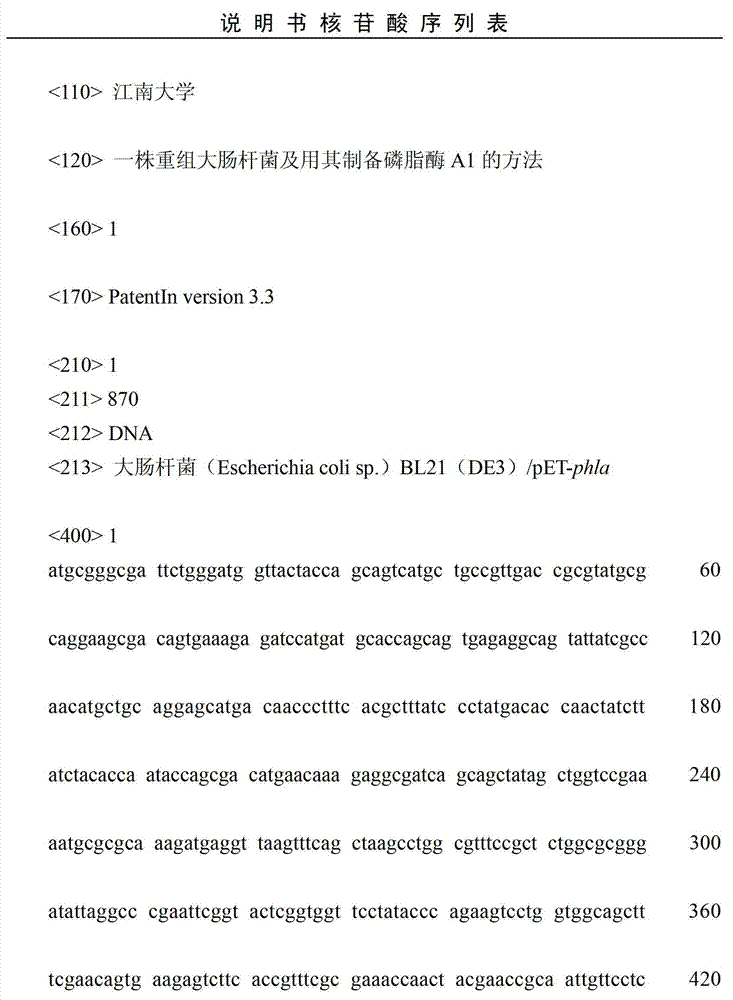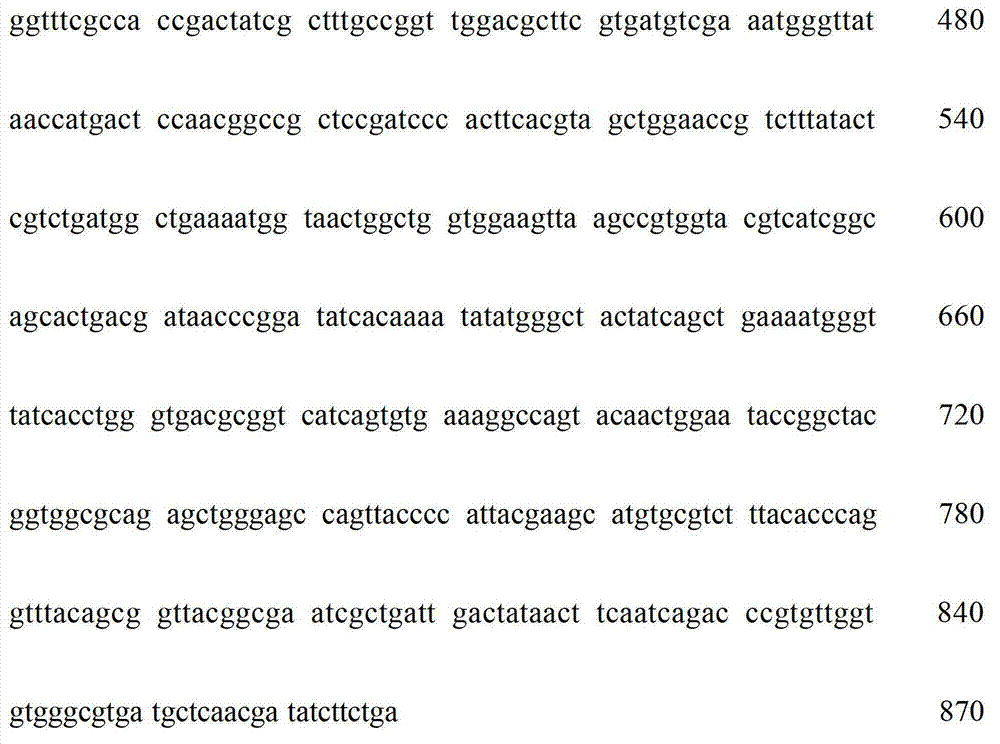Recombinant escherichia coli and method for preparing phospholipase A1 by same
A technology of recombinant Escherichia coli and phospholipase, applied in the field of genetic engineering and microbial fermentation, can solve the problems of limited extraction, late start, and low yield
- Summary
- Abstract
- Description
- Claims
- Application Information
AI Technical Summary
Problems solved by technology
Method used
Image
Examples
Embodiment 1
[0029] Example 1 Phospholipase A 1 Gene cloning
[0030] Design primers according to the gene sequence numbered ATCC 29220 provided by NCBI GenBank database, where the upstream primer is: 5’-G GAATTC GATGCGGGCGATTCTG-3' (underline indicates EcoRI restriction site), the downstream primer is: 5'- CGAGCTC TCAGGTCGCTGCGATGTC-3' (underline indicates HindⅢ restriction site).
[0031] The genomic DNA of Citrobacter youngseri with the deposit number CICC No. 21596 was used as a template, and the phospholipase A was cloned by PCR (primers mentioned above) 1 Gene phla, and ligated with the vector pMD18T-simple to obtain the cloning vector pMD-phla. The cloning vector was transformed into E. coli competent cells E. coli JM109. Positive clones were selected and sequenced for verification. The base sequence is shown in SEQ ID NO:1 Show, the results show that phospholipase A 1 Gene cloning was successful. Sequence analysis showed that the gene sequence is similar to the above-mentioned phosph...
Embodiment 2
[0032] Example 2 Construction of recombinant vector pET-phla
[0033] The recombinant vector pMD-phla and the expression vector pET-28a(+) were double digested with EcoR I and HindⅢ. The digestion reaction system was 50μL: vector 20μL, enzyme reaction buffer 5μL, EcoR I 2.5μL, HindⅢ2.5μL, supplement Double-evaporate deionized water to 50μL and react at 37°C for 2 hours. Recover the digested target gene and vector DNA and ligate with T4 DNA ligase. The ligation reaction system 10μL: target gene 2μL, carrier DNA 1μL, 10×T4 ligase Buffer 1μL, T4 DNA ligase 1μL, double distilled to deionize Water 5μL, react at 16°C for 12h.
[0034] The ligation product was transformed into E.coli JM109 competent cell, the transformation method is as follows:
[0035] (1) Take 100μL of E.coli JM109 and place it in a sterile 1.5ml EP tube;
[0036] (2) Add the above-mentioned connection product and mix gently;
[0037] (3) Put the above EP tube in a 42℃ metal bath, time accurately for 90s, do not shake th...
Embodiment 3
[0042] Example 3 Construction of recombinant E. coli BL21(DE3) / pET-phla CCTCC M 2012424
[0043] The constructed recombinant vector pET-phla is transformed into E. coli BL21 (DE3), the transformation method is as follows:
[0044] (1) Take 100μL of E.coli BL21 (DE3) and place it in a sterile 1.5ml EP tube;
[0045] (2) Add the above recombinant plasmid pET-phla and mix gently;
[0046] (3) Put the above EP tube in a 42℃ metal bath, time accurately for 90s, do not shake the EP tube;
[0047] (4) Transfer the EP tube to an ice bath and cool for 5-10 minutes;
[0048] (5) Add 800μL of sterile SOC medium to each tube and place it in a 37°C incubator for recovery for 1 hour;
[0049] (6) Centrifuge at 8000r / min for 2 minutes, aspirate 800μL of supernatant medium, gently pipette the remaining medium and cells, and transfer to LB solid containing a final concentration of 50μg / ml kanamycin Plate, spread evenly and incubate at 37℃ incubator for 16-24 hours;
[0050] (7) Pick the transformants, and...
PUM
 Login to View More
Login to View More Abstract
Description
Claims
Application Information
 Login to View More
Login to View More - R&D
- Intellectual Property
- Life Sciences
- Materials
- Tech Scout
- Unparalleled Data Quality
- Higher Quality Content
- 60% Fewer Hallucinations
Browse by: Latest US Patents, China's latest patents, Technical Efficacy Thesaurus, Application Domain, Technology Topic, Popular Technical Reports.
© 2025 PatSnap. All rights reserved.Legal|Privacy policy|Modern Slavery Act Transparency Statement|Sitemap|About US| Contact US: help@patsnap.com


